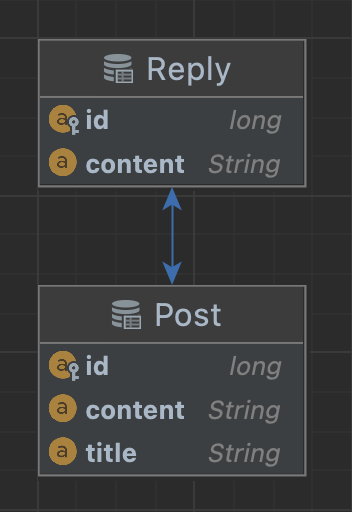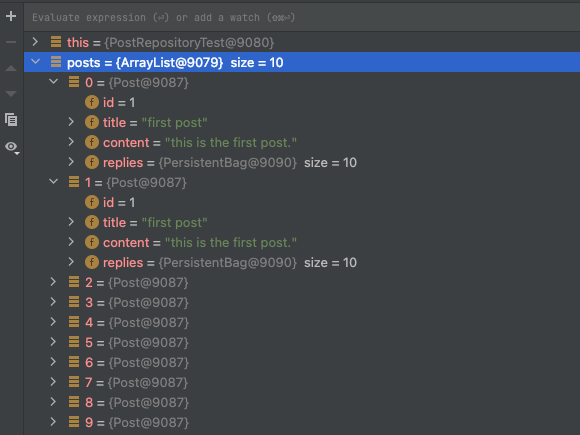JPA N+1 Problem
👉 이어서 읽기를 추천합니다.
0. 들어가면서
클린 코드를 읽다보니 이런 문구가 있었습니다.
우리 모두는 자신이 짠 쓰레기 코드를 쳐다보며 나중에 손보겠다고 생각한 경험이 있다. 우리 모두는 대충 짠 프로그램이 돌아간다는 사실에 안도감을 느끼며 그래도 안 돌아가는 프로그램보다 돌아가는 쓰레기가 좋다고 스스로를 위로한 경험이 있다. 다시 돌아와 나중에 정리하겠다고 다짐했었다. 물론 그 시절 우리는 르블랑의 법칙(leblanc’s law)을 몰랐다.
나중은 결코 오지 않는다.
책을 읽고 나니 이전 프로젝트에서 JPA N+1 현상으로 인해 성능 문제가 있었던 코드가 생각났습니다. 갑자기 이를 너무 개선하고 싶어졌습니다.
문제가 있는 코드에 대한 테스트를 작성해나가면서 관련된 기능을 천천히 고쳐나가는 일은 생각보다 재밌었습니다.
성능을 개선하는 과정을 통해 몇 가지를 배웠는데, 우선 JPA N+1 현상과 관련된 내용을 정리해놓질 않았기 때문에 공부할 겸 포스트로 정리하였습니다.
이번 포스트에선 @OneToMany, @ManyToOne 애너테이션을 기준으로 이야기를 진행하겠습니다.
1. JPA N+1 Problem
@OneToOne, @OneToMany, @ManyToOne 같은 애너테이션으로 엔티티 사이에 관계가 형성되어 있을 때 불필요한 쿼리가 더 수행되는 현상을 의미합니다.
N+1 문제 현상
- 아래 이미지를 보면 Post 엔티티와 Reply 엔티티는 1 대 N 관계입니다.
- JPA
findBy-메소드를 사용하여 1개의 Post 엔티티를 조회하면, 쿼리가 총 2회 수행됩니다.- 지연 로딩(lazy loading)인 경우 해당 객체를 사용했다고 가정합니다.
- Post 엔티티를 조회하는 쿼리 1회
- Reply 엔티티들을 조회하는 쿼리 1회
Hibernate: select post0_.id as id1_0_, post0_.content as content2_0_, post0_.title as title3_0_ from post post0_ where post0_.title=? limit ?
Hibernate: select replies0_.post_id as post_id3_1_0_, replies0_.id as id1_1_0_, replies0_.id as id1_1_1_, replies0_.content as content2_1_1_, replies0_.post_id as post_id3_1_1_ from reply replies0_ where replies0_.post_id=?
- 만약, 2개의 Post 엔티티를 조회하면, 쿼리는 총 3회 수행됩니다.
- 지연 로딩(lazy loading)인 경우 해당 객체를 사용했다고 가정합니다.
- 2개의 Post 엔티티들을 조회하는 쿼리 1회
- (각 Post 엔티티 별로 Reply 엔티티들을 조회하는 쿼리 1회) * (Post 엔티티 갯수 2개) = 2회
Hibernate: select post0_.id as id1_0_, post0_.content as content2_0_, post0_.title as title3_0_ from post post0_
Hibernate: select replies0_.post_id as post_id3_1_0_, replies0_.id as id1_1_0_, replies0_.id as id1_1_1_, replies0_.content as content2_1_1_, replies0_.post_id as post_id3_1_1_ from reply replies0_ where replies0_.post_id=?
Hibernate: select replies0_.post_id as post_id3_1_0_, replies0_.id as id1_1_0_, replies0_.id as id1_1_1_, replies0_.content as content2_1_1_, replies0_.post_id as post_id3_1_1_ from reply replies0_ where replies0_.post_id=?
- 만약, N개의 Post 엔티티를 조회하면, 쿼리는 총 N+1회 수행됩니다.
2. N+1 문제 해결하기
N+1 문제에 대해 알아보았으니 이를 해결할 수 있는 방법을 찾아보겠습니다. 우선 테스트에 사용될 엔티티들을 살펴보고, 다음으로 해결 방법들을 알아보겠습니다.
2.1. 테스트에 사용한 엔티티
Post 엔티티
package blog.in.action.post;
import blog.in.action.reply.Reply;
import lombok.*;
import javax.persistence.*;
import java.util.ArrayList;
import java.util.List;
@Builder
@Getter
@Setter
@AllArgsConstructor
@NoArgsConstructor
@Entity
public class Post {
@Id
@GeneratedValue(strategy = GenerationType.AUTO)
private long id;
@Column
private String title;
@Column
private String content;
@OneToMany(mappedBy = "post")
private List<Reply> replies;
public void addReply(Reply reply) {
if (replies == null) {
replies = new ArrayList<>();
}
replies.add(reply);
}
}
Reply 엔티티
package blog.in.action.reply;
import blog.in.action.post.Post;
import lombok.*;
import javax.persistence.*;
@Builder
@Getter
@Setter
@AllArgsConstructor
@NoArgsConstructor
@Entity
public class Reply {
@Id
@GeneratedValue(strategy = GenerationType.AUTO)
private long id;
@Column
private String content;
@ManyToOne
@JoinColumn(name = "post_id")
private Post post;
}
2.2. join fetch 키워드 사용하기
@Query 애너테이션과 JPQL(Java Persistence Query Language)를 사용하여 fetch 조인(join) 쿼리를 작성합니다.
fetch 조인은 inner join 처리됩니다.
2.2.1. 테스트 코드
package blog.in.action.post;
import blog.in.action.reply.Reply;
import org.junit.jupiter.api.BeforeEach;
import org.junit.jupiter.api.Test;
import org.springframework.beans.factory.annotation.Autowired;
import org.springframework.boot.test.autoconfigure.orm.jpa.DataJpaTest;
import javax.persistence.EntityManager;
import java.util.List;
import java.util.Set;
import java.util.stream.Collectors;
import static org.assertj.core.api.AssertionsForClassTypes.assertThat;
@DataJpaTest
public class PostRepositoryTest {
@Autowired
private EntityManager em;
@Autowired
private PostRepository postRepository;
Post getPost(String title, String content) {
return Post.builder()
.title(title)
.content(content)
.build();
}
void insertReply(Post post, String content) {
for (int index = 0; index < 10; index++) {
Reply reply = Reply.builder()
.content(content + index)
.post(post)
.build();
post.addReply(reply);
em.persist(reply);
}
}
@BeforeEach
public void setup() {
Post post = getPost("first post", "this is the first post.");
Post secondPost = getPost("second post", "this is the second post.");
postRepository.save(post);
postRepository.save(secondPost);
insertReply(post, "first-reply-");
insertReply(secondPost, "second-reply-");
em.flush();
em.clear();
}
@Test
public void whenFindDistinctByTitleFetchJoin_thenJustOneQuery() {
List<Post> posts = postRepository.findDistinctByTitleFetchJoin("first post");
List<String> replyContents = posts
.stream()
.map(post -> post.getReplies())
.flatMap(replies -> replies.stream())
.map(reply -> reply.getContent())
.collect(Collectors.toList());
assertThat(replyContents.size()).isEqualTo(10);
}
@Test
public void whenFindByTitleFetchJoin_thenJustOneQuery() {
Set<Post> posts = postRepository.findByTitleFetchJoin("first post");
List<String> replyContents = posts
.stream()
.map(post -> post.getReplies())
.flatMap(replies -> replies.stream())
.map(reply -> reply.getContent())
.collect(Collectors.toList());
assertThat(replyContents.size()).isEqualTo(10);
}
}
2.2.2. 구현 코드
findDistinctByTitleFetchJoin메소드- 반환 타입이
List - 쿼리 결과 DISTINCT 처리
- 반환 타입이
findByTitleFetchJoin메소드- 반환 타입이
Set
- 반환 타입이
package blog.in.action.post;
import org.springframework.data.jpa.repository.EntityGraph;
import org.springframework.data.jpa.repository.JpaRepository;
import org.springframework.data.jpa.repository.Query;
import java.util.List;
import java.util.Set;
public interface PostRepository extends JpaRepository<Post, Long> {
@Query(value = "SELECT DISTINCT p FROM Post p JOIN FETCH p.replies WHERE p.title = :title")
List<Post> findDistinctByTitleFetchJoin(String title);
@Query(value = "SELECT p FROM Post p JOIN FETCH p.replies WHERE p.title = :title")
Set<Post> findByTitleFetchJoin(String title);
}
2.2.3. 테스트 수행 결과
whenFindDistinctByTitleFetchJoin_thenJustOneQuery테스트 수행 쿼리
-- inner join 쿼리가 수행되면서 한번에 Reply 엔티티 정보를 조회합니다.
select distinct post0_.id as id1_0_0_,
replies1_.id as id1_1_1_,
post0_.content as content2_0_0_,
post0_.title as title3_0_0_,
replies1_.content as content2_1_1_,
replies1_.post_id as post_id3_1_1_,
replies1_.post_id as post_id3_1_0__,
replies1_.id as id1_1_0__
from post post0_
inner join reply replies1_ on post0_.id = replies1_.post_id
where post0_.title = ?
whenFindByTitleFetchJoin_thenJustOneQuery테스트 수행 쿼리
-- inner join 쿼리가 수행되면서 한번에 Reply 엔티티 정보를 조회합니다.
select post0_.id as id1_0_0_,
replies1_.id as id1_1_1_,
post0_.content as content2_0_0_,
post0_.title as title3_0_0_,
replies1_.content as content2_1_1_,
replies1_.post_id as post_id3_1_1_,
replies1_.post_id as post_id3_1_0__,
replies1_.id as id1_1_0__
from post post0_
inner join reply replies1_ on post0_.id = replies1_.post_id
where post0_.title = ?
2.3. @EntityGraph 애너테이션 사용
@EntityGraph 애너테이션을 사용하여 조인할 대상 필드를 지정합니다.
해당 애너테이션에 포함된 필드는 쿼리시 left outer join 대상 테이블이 됩니다.
2.3.1. 테스트 코드
package blog.in.action.post;
import blog.in.action.reply.Reply;
import org.junit.jupiter.api.BeforeEach;
import org.junit.jupiter.api.Test;
import org.springframework.beans.factory.annotation.Autowired;
import org.springframework.boot.test.autoconfigure.orm.jpa.DataJpaTest;
import javax.persistence.EntityManager;
import java.util.List;
import java.util.Set;
import java.util.stream.Collectors;
import static org.assertj.core.api.AssertionsForClassTypes.assertThat;
@DataJpaTest
public class PostRepositoryTest {
@Autowired
private EntityManager em;
@Autowired
private PostRepository postRepository;
Post getPost(String title, String content) {
return Post.builder()
.title(title)
.content(content)
.build();
}
void insertReply(Post post, String content) {
for (int index = 0; index < 10; index++) {
Reply reply = Reply.builder()
.content(content + index)
.post(post)
.build();
post.addReply(reply);
em.persist(reply);
}
}
@BeforeEach
public void setup() {
Post post = getPost("first post", "this is the first post.");
Post secondPost = getPost("second post", "this is the second post.");
postRepository.save(post);
postRepository.save(secondPost);
insertReply(post, "first-reply-");
insertReply(secondPost, "second-reply-");
em.flush();
em.clear();
}
@Test
public void whenFindDistinctByTitleEntityGraph_thenJustOneQuery() {
List<Post> posts = postRepository.findDistinctByTitleEntityGraph("first post");
List<String> replyContents = posts
.stream()
.map(post -> post.getReplies())
.flatMap(replies -> replies.stream())
.map(reply -> reply.getContent())
.collect(Collectors.toList());
assertThat(posts.size()).isEqualTo(1);
assertThat(replyContents.size()).isEqualTo(10);
}
@Test
public void whenFindByTitleEntityGraph_thenJustOneQuery() {
Set<Post> posts = postRepository.findByTitleEntityGraph("first post");
List<String> replyContents = posts
.stream()
.map(post -> post.getReplies())
.flatMap(replies -> replies.stream())
.map(reply -> reply.getContent())
.collect(Collectors.toList());
assertThat(posts.size()).isEqualTo(1);
assertThat(replyContents.size()).isEqualTo(10);
}
}
2.3.2. 구현 코드
findDistinctByTitleEntityGraph메소드- 반환 타입이
List - 쿼리 결과 DISTINCT 처리
@EntityGraph애너테이션에 함께 조회할 엔티티 정보 표시
- 반환 타입이
findByTitleEntityGraph메소드- 반환 타입이
Set @EntityGraph애너테이션에 함께 조회할 엔티티 정보 표시
- 반환 타입이
public interface PostRepository extends JpaRepository<Post, Long> {
@EntityGraph(attributePaths = {"replies"})
@Query(value = "SELECT DISTINCT p FROM Post p WHERE p.title = :title")
List<Post> findDistinctByTitleEntityGraph(String title);
@EntityGraph(attributePaths = {"replies"})
@Query(value = "SELECT p FROM Post p WHERE p.title = :title")
Set<Post> findByTitleEntityGraph(String title);
}
2.3.3. 테스트 수행 결과
whenFindDistinctByTitleEntityGraph_thenJustOneQuery테스트 수행 쿼리
-- left outer join 쿼리가 수행되면서 한번에 Reply 엔티티 정보를 조회합니다.
select distinct post0_.id as id1_0_0_,
replies1_.id as id1_1_1_,
post0_.content as content2_0_0_,
post0_.title as title3_0_0_,
replies1_.content as content2_1_1_,
replies1_.post_id as post_id3_1_1_,
replies1_.post_id as post_id3_1_0__,
replies1_.id as id1_1_0__
from post post0_
left outer join reply replies1_ on post0_.id = replies1_.post_id
where post0_.title = ?
whenFindByTitleEntityGraph_thenJustOneQuery테스트 수행 쿼리
-- left outer join 쿼리가 수행되면서 한번에 Reply 엔티티 정보를 조회합니다.
select post0_.id as id1_0_0_,
replies1_.id as id1_1_1_,
post0_.content as content2_0_0_,
post0_.title as title3_0_0_,
replies1_.content as content2_1_1_,
replies1_.post_id as post_id3_1_1_,
replies1_.post_id as post_id3_1_0__,
replies1_.id as id1_1_0__
from post post0_
left outer join reply replies1_ on post0_.id = replies1_.post_id
where post0_.title = ?
3. 주의사항
3.1. SQL 데이터 조회 결과
테스트를 보면 fetch 조인과 @EntityGraph 애너테이션을 사용하면 inner join과 left outer join 방식을 사용한 쿼리로 데이터를 조회합니다.
두 조인 방식 모두 일대다 관계에서 "일"인 테이블을 기준으로 데이터를 조회하면 중복되는 데이터가 발생합니다.
Post 테이블 조회 쿼리 수행 및 결과
select * from test.post;
| post.id | post.content | post.title |
|---|---|---|
| 1 | this is the first post. | first post |
Reply 테이블 조회 쿼리 수행 및 결과
select * from test.reply;
| reply.id | reply.content | reply.post_id |
|---|---|---|
| 1 | first-reply-1 | 1 |
| 2 | first-reply-2 | 1 |
| 3 | first-reply-3 | 1 |
| 4 | first-reply-4 | 1 |
| 5 | first-reply-5 | 1 |
| 6 | first-reply-6 | 1 |
| 7 | first-reply-7 | 1 |
| 8 | first-reply-8 | 1 |
| 9 | first-reply-9 | 1 |
| 10 | first-reply-10 | 1 |
inner join 쿼리 수행시 결과
select *
from test.post inner join test.reply on test.post.id = test.reply.post_id;
| post.id | post.content | post.title | reply.id | reply.content | reply.post_id |
|---|---|---|---|---|---|
| 1 | this is the first post. | first post | 1 | first-reply-1 | 1 |
| 1 | this is the first post. | first post | 2 | first-reply-2 | 1 |
| 1 | this is the first post. | first post | 3 | first-reply-3 | 1 |
| 1 | this is the first post. | first post | 4 | first-reply-4 | 1 |
| 1 | this is the first post. | first post | 5 | first-reply-5 | 1 |
| 1 | this is the first post. | first post | 6 | first-reply-6 | 1 |
| 1 | this is the first post. | first post | 7 | first-reply-7 | 1 |
| 1 | this is the first post. | first post | 8 | first-reply-8 | 1 |
| 1 | this is the first post. | first post | 9 | first-reply-9 | 1 |
| 1 | this is the first post. | first post | 10 | first-reply-10 | 1 |
3.2. JPA 엔티티 중복 처리 미수행 조회 결과
위처럼 중복되는 데이터 행(row)의 모습은 JPA를 이용한 엔티티 조회에서도 반영됩니다.
이런 중복 현상을 없애기 위해선 메소드의 리턴 타입을 Set으로 지정하거나 쿼리 내부에 DISTINCT 키워드를 붙혀야 합니다.
중복을 없애기 위한 처리를 하지 않으면 아래와 같은 결과를 확인할 수 있습니다.
중복 데이터 조회
- 리턴 타입은
List이며, 쿼리 내부에DISTINCT키워드를 붙히지 않은 경우입니다. - 결과 리스트에 주소가 같은 엔티티 객체가 10개 담겨서 반환됩니다.
CLOSING
@NamedEntityGraphs 애너테이션을 이용한 해결 방법도 있지만, 참고한 이동욱님 블로그를 보면 다음과 같은 내용을 볼 수 있습니다.
NamedEntityGraphs의 경우 Entity에 관련해서 모든 설정 코드를 추가해야하는데, 개인적으론 Entity가 해야하는 책임에 포함되지 않는다고 생각합니다. A 로직에서는 Fetch전략을 어떻게 가져가야 한다는 것은 해당 로직의 책임이지, Entity의 책임이 아니라고 생각합니다. Entity에선 실제 도메인에 관련 된 코드만 작성하고, 상황에 따라 유동적인 Fetch 전략을 가져가는 것은 전적으로 서비스/레파지토리에서 결정해야하는 일이라고 생각됩니다.
저도 마찬가지 의견을 가지고 있기 때문에 추가적인 정리는 하지 않았습니다. 혹시 나중에 사용할 일이 생긴다면 그때 관련된 내용을 정리해보도록 하겠습니다.
추가적으로 @EntityGraph 애너테이션을 사용하면 데이터 중복 현상을 없애기 위한 처리 없이도 정상적으로 엔티티가 조회됩니다.
리턴 타입을 Set으로 지정하거나 쿼리 내부에 DISTINCT 키워드가 없어도 중복되지 않은 엔티티 리스트가 반환됩니다.
GitHub spring-data-jpa 레포지토리 이슈와 StackOverflow 질문으로 @EntityGraph 애너테이션을 사용할 때 왜 중복 현상이 발생하지 않는지 문의하였습니다.



댓글남기기